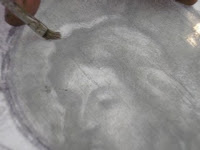 More painting being removed.
More painting being removed. And more highlights created.
And more highlights created. Around the perimeter of the head.
Around the perimeter of the head. And yet more detail being added. At this point, the glass will probably be placed in a kiln and fired to over 1300 degrees to make the paint permanent.
And yet more detail being added. At this point, the glass will probably be placed in a kiln and fired to over 1300 degrees to make the paint permanent.
After firing for about four hours, and then cooling, another layer of painting is added depending upon the effects desired. This procedure might be repeated from 3-6 firings, depending upon the details and colors desired in the glass piece. It is a good idea not to fire the same piece of glass more than a half dozen times. A good glass painter can ordinarily achieve fine results within these parameters. More firing can result in destabilization of the glass itself.



No comments:
Post a Comment